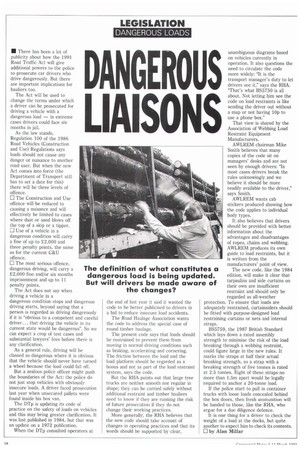DANGEROUS LIAISONS
Page 40

If you've noticed an error in this article please click here to report it so we can fix it.
• There has been a lot of publicity about how the 1991 Road Traffic Act will give additional powers to the police to prosecute car drivers who drive dangerously. But there are important implications for hauliers too.
The Act will be used to change the terms under which a driver can be prosecuted for driving a vehicle with a dangerous load — in extreme cases drivers could face six months in jail.
As the law stands, Regulation 100 of the 1986 Road Vehicles (Construction and Use) Regulations says loads should not cause any danger or nuisance to another road user. But when the new Act comes into force (the Department of Transport still has to set a date for this) there will be three levels of offence.
0 The Construction and Use offence will be reduced to causing a nuisance and will effectively be limited to cases where dust or sand blows off the top of a skip or a tipper. 0 Use of a vehicle in a dangerous condition will carry a fine of up to £2,000 and three penalty points, the same as for the current C&U offence.
0 The most serious offence, dangerous driving, will carry a £2,000 fine and/or six months imprisonment and up to 11 penalty points.
The Act does not say when driving a vehicle in a dangerous condition stops and dangerous driving starts, beyond saying that a person is regarded as driving dangerously if it is 'obvious to a competent and careful driver.., that driving the vehicle in its current state would be dangerous". So we can expect a crop of test cases and substantial lawyers' fees before there is any clarification.
As a general rule, driving will be classed as dangerous where it is obvious that the vehicle should never have turned a wheel because the load could fall off.
But a zealous police officer might push the boundaries of the Act: the police do not just stop vehicles with obviously insecure loads. A driver faced prosecution last year when unsecured pallets were found inside his box van.
The Dip is updating its code of practice on the safety of loads on vehicles and this may bring greater clarification. It was last published in 1984, but that was an update on a 1972 publication.
When the DTp consulted operators at the end of last year it said it wanted the code to be better publicised to drivers in a bid to reduce insecure load accidents.
The Road Haulage Association wants the code to address the special case of round timber haulage.
The present code says that loads should be restrained to prevent them from moving in normal driving conditions such as braking, accelerating and cornering. The friction between the load and the load platform should be regarded as a bonus and not as part of the load restraint system, says the code.
But the RHA points out that large tree trucks are neither smooth nor regular in shape; they can be carried safely without additional restraint and timber hauliers need to know if they are running the risk of future prosecution if they do not change their working practices.
More generally, the RHA believes that the new code should take account of changes in operating practices and that its words should be supported by clear, unambiguous diagrams based on vehicles currently in operation. It also questions the need to circulate the code more widely: "It is the transport manager's duty to let drivers see it," says the RHA. "That's what BS5750 is all about. Not letting him see the code on load restraints is like sending the driver out without a map or not having 10p to use a phone box."
That view is shared by the Association of Webbing Load Restraint Equipment Manufacturers.
AWLREM chairman Mike Smith believes that many copies of the code sit on managers' desks and are not seen by enough drivers: "In most cases drivers break the rules unknowingly and we believe it should be more readily available to the driver," says Smith.
AWLREM wants cab stickers produced showing how the code applies to individual body types.
It also believes that drivers should be provided with better information about the advantages and disadvantages of ropes, chains and webbing. AWLREM produces its own guide to load restraints, but it is written from the manufacturers' point of view.
The new code, like the 1984 edition, will make it clear that tarpaulins and side curtains on their own are insufficient restraint and should only be regarded as all-weather protection. To ensure that loads are adequately restrained, curtainsiders should be fitted with purpose-designed load restraining curtains or nets and internal straps.
BS5759, the 1987 British Standard which lays down a rated assembly strength to minimise the risk of the load breaking through a webbing restraint, could figure large in the new rules. It marks the straps at half their actual breaking strength, so a strap with a breaking strength of five tonnes is rated at 2.5 tonnes. Eight of these straps no more than 1.5m apart would be legally required to anchor a 20-tonne load.
If the police start to pull in container trucks with loose loads concealed behind the box doors, then fresh ammunition will be handed to those, like the RHA, who argue for a due diligence defence.
It is one thing for a driver to check the weight of a load at the docks, but quite another to expect him to check its contents. 0 by Alan Millar












































































































